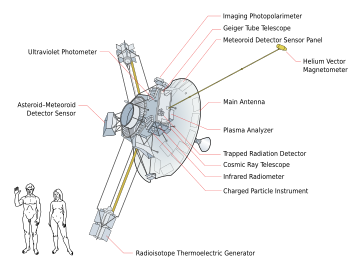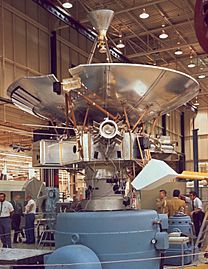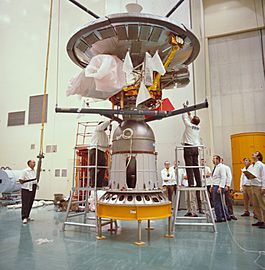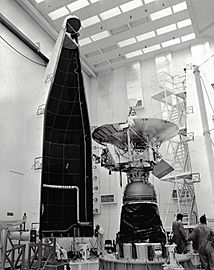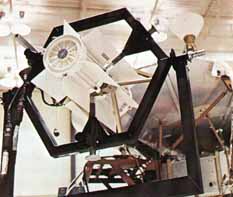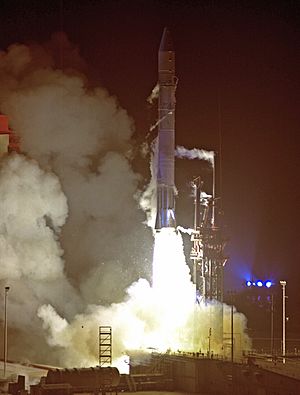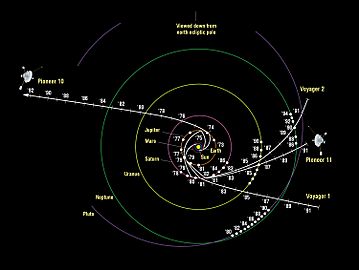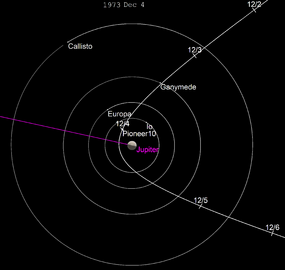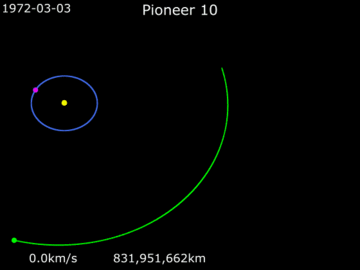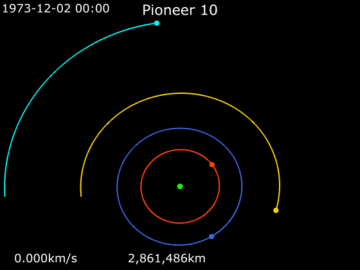Pioneer 10 facts for kids
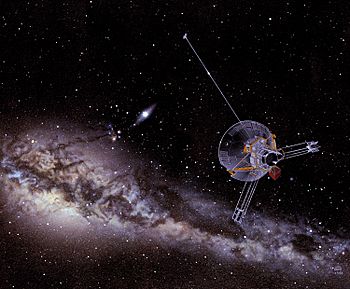
Artist's conception of the Pioneer 10 spacecraft
|
|
| Mission type | Outer Solar System and heliosphere exploration |
|---|---|
| Operator | |
| Website | Pioneer Project website (archived) NASA Archive page |
| Mission duration | 30 years, 10 months and 21 days |
| Spacecraft properties | |
| Manufacturer | |
| Launch mass | 258 kg |
| Power | 155 watts (at launch) |
| Start of mission | |
| Launch date | March 3, 1972 at 01:49:04 UTC |
| Rocket | Atlas SLV-3C Centaur-D Star-37E |
| Launch site | Cape Canaveral LC-36A |
| End of mission | |
| Last contact | Last telemetry April 27, 2002; last signal received January 23, 2003 |
| Flyby of Jupiter | |
| Closest approach | December 3, 1973 |
| Distance | 132,252 km (82,178 mi) |
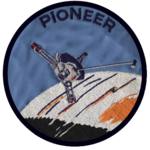
|
|
Pioneer 10 was a NASA space probe launched in 1972. Its main goal was to be the first spacecraft to visit the giant planet Jupiter. Pioneer 10 also made history by becoming the first human-made object to travel fast enough to leave our Solar System.
This amazing space journey was managed by the NASA Ames Research Center in California. The spacecraft itself was built by a company called TRW Inc..
Pioneer 10 was built around a six-sided body. It had a large, round antenna that was about 2.74 meters (9 feet) wide. The spacecraft spun around to stay stable, like a spinning top. Its power came from four special generators called radioisotope thermoelectric generators (RTGs). These generators produced 155 watts of power when the spacecraft launched.
The probe launched on March 3, 1972, from Cape Canaveral, Florida. It was carried into space by an Atlas-Centaur rocket. Between July 1972 and February 1973, Pioneer 10 became the first spacecraft to fly through the asteroid belt. It started taking pictures of Jupiter on November 6, 1973. It sent back about 500 images. The closest it got to Jupiter was on December 3, 1973, flying about 132,252 kilometers (82,177 miles) away.
During its mission, Pioneer 10 studied the asteroid belt and Jupiter's surroundings. It also looked at the solar wind, cosmic rays, and the outer parts of our Solar System.
NASA lost contact with Pioneer 10 on January 23, 2003. This happened because its power system could no longer run its radio transmitter. At that time, the probe was about 12 billion kilometers (7.5 billion miles) from Earth.
Contents
The Pioneer 10 Mission: A Journey to Jupiter
Why Explore Jupiter?
In the 1960s, scientists at NASA had a big idea. They wanted to send spacecraft to the outer planets of our Solar System. This was called the "Planetary Grand Tour." It would use a rare alignment of planets to help spacecraft travel far. To get ready for this, NASA decided to send two probes to the outer Solar System.
A group of scientists, led by James Van Allen, explained why exploring these planets was important. NASA then planned to send two "Galactic Jupiter Probes." These probes would fly through the asteroid belt and visit Jupiter. The best times to launch these missions were in 1972 and 1973. Launching at other times would have used too much fuel.
Building the Spacecraft
NASA approved the mission in February 1969. The two spacecraft were first called Pioneer F and Pioneer G. Later, they became Pioneer 10 and Pioneer 11. They were part of the Pioneer program, a series of uncrewed space missions. Pioneer 10 was the first in this series designed to explore the outer Solar System.
The early goals were to study the space between Mars and Jupiter. They also wanted to explore the asteroid belt. Scientists wanted to see if it was dangerous for spacecraft. Finally, they aimed to explore Jupiter and its environment. Later, they added the goal of studying how Jupiter's strong radiation would affect the spacecraft.
Over 150 science experiments were suggested for these missions. The ones chosen would take pictures of Jupiter and its moons. They would also observe Jupiter in infrared and ultraviolet light. The probes would look for asteroids and meteoroids. They would measure charged particles, magnetic fields, and cosmic rays. By tracking the spacecraft as it passed behind Jupiter, scientists could learn about Jupiter's atmosphere.
NASA's Ames Research Center was chosen to manage the project. They had experience with spacecraft that spun to stay stable. The mission needed a small, light spacecraft that was also "magnetically clean." This meant it wouldn't interfere with its own magnetic sensors. It also had to use parts that had worked well on earlier Pioneer missions.
In February 1970, NASA gave a contract to TRW Inc. to build both Pioneer 10 and 11. This was done quickly to save time. Building the spacecraft took about 25 million hours of work. One engineer joked that the spacecraft was "guaranteed for two years of interplanetary flight."
The first launch needed to happen between February 29 and March 17, 1972. This would allow it to reach Jupiter in December 1973. This timing helped avoid conflicts with other missions using NASA's Deep Space Network. It also avoided a time when Earth and Jupiter would be on opposite sides of the Sun. The path chosen for Pioneer 10 was risky. It would fly very close to Jupiter to gather more data on its radiation environment. Scientists thought it could survive this close approach.
How Pioneer 10 Was Designed
The main body of Pioneer 10 was 36 centimeters (14 inches) deep. It had six panels that formed a hexagonal (six-sided) shape. This body held the fuel to control the probe's direction. It also housed eight of the eleven science tools. The equipment was protected by a strong aluminum structure. Layers of special insulation kept the spacecraft at the right temperature. Heat from the electrical parts helped keep it warm. The spacecraft weighed about 260 kilograms (573 pounds) at launch.
At launch, Pioneer 10 carried 36 kilograms (79 pounds) of liquid fuel. This fuel was in a spherical tank. Six small thrusters, arranged in three pairs, kept the spacecraft pointed correctly. One pair kept it spinning at 4.8 rotations per minute. Another pair controlled its forward movement. The third pair adjusted its direction. The spacecraft also used a star sensor and two sun sensors to know where it was pointing.
Power and Communication Systems
Pioneer 10 used four SNAP-19 radioisotope thermoelectric generators (RTGs) for power. These were placed on two long booms, each 3 meters (10 feet) long. This kept them far from the sensitive science instruments. Together, the RTGs produced 155 watts of power at launch. This power slowly decreased over time. The spacecraft needed 100 watts to run all its systems.
These generators used plutonium-238 as fuel. Plutonium-238 has a half-life of about 88 years. This means it takes 88 years for half of its radioactive material to decay. Even after 29 years, the RTGs were still producing 80% of their original radiation. However, the electrical parts of the generators wore out faster. By 2001, the total power output was only 65 watts. Because of this, only a few instruments could be used at a time later in the mission.
The space probe had two radio systems. One was connected to the large, dish-shaped antenna. This antenna sent a narrow beam of data. The other was connected to smaller antennas for wider signals. The main antenna was 2.74 meters (9 feet) wide and made of a special aluminum material. The spacecraft spun so this antenna always pointed towards Earth.
Each radio system used an 8-watt transmitter. They sent data using S-band radio waves. Earth sent signals at 2110 MHz, and Pioneer 10 sent data back at 2292 MHz. NASA's Deep Space Network tracked these signals. The data was specially coded to help correct any errors during transmission. At launch, the data rate was 256 bits per second. This rate got slower the farther the spacecraft traveled.
Most of the complex calculations for the mission were done on Earth. Commands were then sent to the spacecraft. Pioneer 10 could store up to five commands at a time. It had a simple computer system to carry out these commands. Mission operators had to plan commands far in advance. The spacecraft also had a data storage unit. It could record up to 6,144 bytes of information from its instruments. A special unit prepared this data in different formats before sending it to Earth.
Science Tools on Board
Pioneer 10 carried many scientific instruments. Each one helped scientists learn more about space.
- Helium Vector Magnetometer (HVM): This tool measured magnetic fields. It helped map Jupiter's magnetic field. It was on a long boom to avoid the spacecraft's own magnetic field.
- Quadrispherical Plasma Analyzer: This looked through a hole in the main antenna. It detected particles from the solar wind, which comes from the Sun.
- Charged Particle Instrument (CPI): This instrument detected cosmic rays in the Solar System.
- Cosmic Ray Telescope (CRT): This collected data on what cosmic ray particles are made of. It also measured their energy levels.
- Geiger Tube Telescope (GTT): This surveyed electrons and protons. It studied them as the spacecraft passed through Jupiter's radiation belts.
- Trapped Radiation Detector (TRD): This tool had different parts to detect various types of radiation. It measured electrons and protons at different energy levels.
- Meteoroid Detectors: Twelve panels with pressurized cells were on the back of the main antenna. They recorded impacts from tiny meteoroids.
- Asteroid/Meteoroid Detector (AMD): This had four telescopes that didn't take pictures. They tracked particles from nearby dust to large, distant asteroids.
- Ultraviolet Photometer: This sensed ultraviolet light. It helped figure out how much hydrogen and helium was in space and on Jupiter.
- Imaging Photopolarimeter (IPP): This was the camera system. It used the spacecraft's spin to scan Jupiter in narrow strips. It looked at the planet in red and blue light. These strips were then combined to create images.
- Infrared Radiometer: This provided information about cloud temperatures on Jupiter. It also measured how much heat Jupiter gave off.
Pioneer 10's Journey Through Space
Launch and Travel Path
Pioneer 10 launched on March 3, 1972, at 1:49 AM UTC. It lifted off from Cape Canaveral in Florida. An Atlas-Centaur rocket carried it into space. The third stage of the rocket was a special solid-fuel stage. This stage gave the spacecraft a final push and made it spin. The spacecraft started spinning at 30 rotations per minute.
Twenty minutes after launch, three long booms extended from the spacecraft. This slowed its spin rate to 4.8 rotations per minute. This spin rate was kept for the entire journey. The rocket pushed the probe for 17 minutes. It reached an incredible speed of 51,682 kilometers per hour (32,113 mph).
After the main antenna was ready, some instruments were turned on for testing. This happened while the spacecraft was still passing through Earth's radiation belts. Ninety minutes after launch, Pioneer 10 reached interplanetary space. It flew past the Moon in just 11 hours. This made it the fastest human-made object at that time. Two days after launch, all the science instruments were turned on.
During the first seven months, the spacecraft made three small course corrections. Its instruments were checked. The cameras looked at Jupiter and the Zodiacal light. Other tools measured cosmic rays, magnetic fields, and the solar wind. The only problem was that a sensor that used the star Canopus failed. So, the spacecraft used its two sun sensors to stay pointed correctly.
As it traveled through space, Pioneer 10 made an important discovery. It was the first mission to detect helium atoms between the planets. It also saw high-energy particles of aluminum and sodium in the solar wind. In August 1972, it recorded data from a powerful solar shock wave. This happened when it was 2.2 times farther from the Sun than Earth is.
On July 15, 1972, Pioneer 10 became the first spacecraft to enter the asteroid belt. This belt is located between the orbits of Mars and Jupiter. Scientists expected the spacecraft to pass through safely. The closest it came to any known asteroid was 8.8 million kilometers (5.5 million miles). One close approach was to asteroid 307 Nike on December 2, 1972.
The instruments showed that there were fewer very small particles in the belt than expected. The number of dust particles between 10 and 100 micrometers did not change much. This was true from Earth's orbit to the edge of the asteroid belt. Only for particles between 100 micrometers and 1 millimeter did the density increase. It was three times higher in the belt. No large fragments were seen in the belt. This meant they were much rarer than scientists thought. Pioneer 10 passed safely through the belt. It emerged on the other side around February 15, 1973.
-
NASA map showing trajectories of the Pioneer 10, Pioneer 11, Voyager 1, and Voyager 2 spacecraft.
Meeting Jupiter Up Close
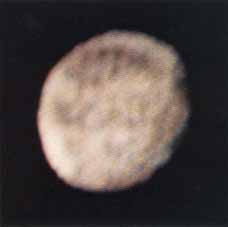
On November 6, 1973, Pioneer 10 was 25 million kilometers (15.5 million miles) from Jupiter. It began testing its imaging system. The data was successfully sent back to Earth. Scientists then uploaded 16,000 commands to the spacecraft. These commands would guide its operations for the next two months. On November 8, it crossed the orbit of Jupiter's outer moon, Sinope.
On November 16, Pioneer 10 reached the edge of Jupiter's magnetosphere. This is like a magnetic bubble around the planet. The speed of the solar wind dropped sharply. A day later, it passed through the magnetopause, the outer boundary of this bubble. The spacecraft's instruments confirmed that Jupiter's magnetic field was opposite to Earth's. By November 29, it had passed all of Jupiter's outermost moons. The spacecraft was working perfectly.
The imaging photopolarimeter started taking red and blue pictures of Jupiter. The spacecraft's spin helped the instrument scan the planet in narrow strips. These red and blue images were combined to make a synthetic green image. Then, all three colors were put together to create a full-color picture. On November 26, twelve such images were received on Earth. By December 2, the image quality was better than any pictures taken from Earth. These images were shown live to the public. The Pioneer program even won an Emmy Award for this. The spacecraft's movement caused some image distortions. These had to be fixed later using computers. In total, over 500 images were sent during the encounter.
Pioneer 10's path took it along Jupiter's magnetic equator. This is where the most intense ion radiation is found. The peak electron radiation was 10,000 times stronger than Earth's maximum radiation. Starting on December 3, Jupiter's radiation caused some false commands to be sent to the spacecraft. Most of these were corrected. However, one image of Io and a few close-ups of Jupiter were lost. Similar false commands happened as the spacecraft left the planet. Despite this, Pioneer 10 successfully took pictures of the moons Ganymede and Europa. The image of Ganymede showed dark areas in the center and near the south pole. Europa was too far away for a detailed picture.
Pioneer 10's path was also chosen to fly behind Io. This allowed scientists to measure how Io's atmosphere affected radio signals. It showed that Io's ionosphere was about 700 kilometers (435 miles) above its surface. The density of electrons ranged from 60,000 per cubic centimeter on the day side to 9,000 on the night side. A surprising discovery was that Io was orbiting within a huge cloud of hydrogen. This cloud stretched for about 805,000 kilometers (500,000 miles). A smaller cloud was also thought to be detected near Europa.
After Pioneer 10 had safely cleared the asteroid belt, NASA decided on a path towards Jupiter. This path would use Jupiter's gravity to slingshot the spacecraft out of the Solar System. Pioneer 10 was the first spacecraft to try this maneuver. It proved that this technique worked. This extended mission was not part of the original plan. But it was added before launch.
At its closest point, the spacecraft reached a speed of 132,000 kilometers per hour (82,000 mph). It came within 132,252 kilometers (82,177 miles) of Jupiter's outer atmosphere. It took close-up images of the Great Red Spot. Communication with the spacecraft stopped as it passed behind the planet. The radio data helped measure the temperature of Jupiter's outer atmosphere. It showed a temperature change between different altitudes. The spacecraft also created an infrared map of Jupiter. This confirmed that the planet gives off more heat than it gets from the Sun.
As Pioneer 10 moved away from Jupiter, it sent back crescent-shaped images of the planet. It then passed through Jupiter's magnetosphere again. Because this magnetic boundary constantly shifts, the spacecraft crossed it 17 times before finally escaping Jupiter's influence.
Journey into Deep Space
Pioneer 10 crossed the orbit of Saturn in 1976. It then crossed the orbit of Uranus in 1979. On June 13, 1983, it crossed the orbit of Neptune. At that time, Neptune was considered the farthest planet. This made Pioneer 10 the first human-made object to leave the area of the major planets. The mission officially ended on March 31, 1997. By then, it was 67 times farther from the Sun than Earth is. However, the spacecraft could still send back some data after this date.
After March 31, 1997, Pioneer 10's weak signal was still tracked by the Deep Space Network. This helped train flight controllers to pick up faint signals from deep space. Scientists even studied ways to get useful data from the fading signal.
The last time scientists successfully received data from Pioneer 10 was on April 27, 2002. Later signals were too weak to provide any useful information. The very last, faint signal from Pioneer 10 was received on January 23, 2003. At that time, it was 12 billion kilometers (7.5 billion miles) from Earth. Further attempts to contact the spacecraft were not successful. A final try was made on March 4, 2006. This was the last time the antenna would be pointed correctly at Earth. No response was received. NASA decided that the power units (RTGs) had likely fallen below the level needed to run the transmitter. So, no more contact attempts were made.
Where is Pioneer 10 Now?
On July 18, 2023, Voyager 2 passed Pioneer 10. This means Pioneer 10 is now the third farthest spacecraft from the Sun. Voyager 1 and Voyager 2 are farther away. Sunlight takes about 18.7 hours to reach Pioneer 10. From the spacecraft, the Sun appears very bright, but much smaller than from Earth.
If nothing disturbs it, Pioneer 10 and its sister craft Pioneer 11 will continue to travel. They will join the two Voyager spacecraft and the New Horizons spacecraft in leaving our Solar System. They will then wander through the space between stars, called the interstellar medium.
Pioneer 10's path is generally towards the star Aldebaran. Aldebaran is currently about 68 light years away. If Aldebaran were not moving, it would take Pioneer 10 over two million years to reach it. Much sooner, in about 90,000 years, Pioneer 10 will pass very close to a star called HIP 117795. This will be the closest stellar flyby for any of the four Pioneer and Voyager spacecraft in the next few million years.
A backup unit of Pioneer 10, called Pioneer H, is on display. You can see it at the National Air and Space Museum in Washington, D.C.. Many things learned from Pioneer 10 were very important. They helped plan the later, very successful Voyager missions.
The Pioneer Plaque
Because Carl Sagan strongly suggested it, Pioneer 10 and Pioneer 11 each carry a special plaque. It is made of gold-anodized aluminum and measures 152 by 229 millimeters (6 by 9 inches). This plaque is there in case either spacecraft is ever found by intelligent life from another star system. The plaques show drawings of a human male and female. They also have symbols that explain where the spacecraft came from. The plaque is attached to the antenna supports. This helps protect it from dust in space.
Pioneer 10 in Pop Culture
- In the movie Star Trek V: The Final Frontier, a Klingon spaceship destroys Pioneer 10 for target practice.
- In the online story 17776, one of the main characters is a sentient (thinking) Pioneer 10.
Images for kids
-
Artist's impression of Pioneer 10's flyby of Jupiter
See also
- Exploration of Jupiter
- Pioneer 11, Jupiter and Saturn fly-by
- Voyager 1 and Voyager 2, Jupiter fly-by en route to other outer Solar System fly-bys
- Galileo, Jupiter orbiter
- Cassini–Huygens, Jupiter fly-by for Saturn orbiter and Titan lander, respectively
- New Horizons, Jupiter flyby en route to Pluto fly-by
- Juno, Jupiter polar orbiter
 In Spanish: Pioneer 10 para niños
In Spanish: Pioneer 10 para niños


